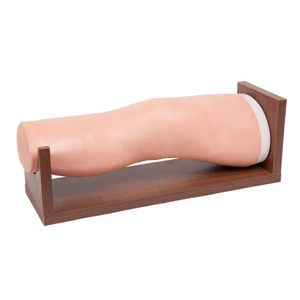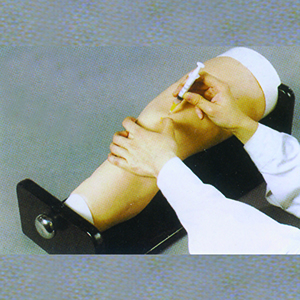

Article tag: Knee injection model| Joint injection model| BIX-CK20135|
The knee injection model provides students with an efficient and safe exercise platform that helps accelerate the transition from theory to practice. Through simulation training, students can not only master the operation skills, but also improve clinical self-confidence and reduce operational errors. With the support of data, model training has been prov...
Knee injection is a common operation in clinic, widely used in the treatment of knee diseases such as arthritis, joint effusion and so on. For medical students and medical staff, mastering this technology requires not only the accumulation of theoretical knowledge, but also a lot of practical experience. The traditional teaching method is usually based on theoretical explanation, and the practical operation opportunity is limited, which delays the mastery of skills to a certain extent. In recent years, the emergence of knee injection training model has provided a revolutionary solution for teaching, and whether it can effectively accelerate the transformation from theory to practice has become an important topic in medical education. This paper will discuss the practical role of knee injection model in clinical teaching from the academic and professional perspective, combined with data analysis.
1. Teaching challenges of knee injection technology

Knee injections usually require the operator to accurately grasp the position, Angle, and force of the puncture point. In actual clinical practice, each operation may face different challenges due to different factors such as patient size and lesion degree. Traditional teaching methods often rely on classroom teaching and a small amount of practical exercises, it is difficult for students to complete the smooth transition from theory to practice in a short time. When facing real patients, students may feel nervous due to lack of sufficient practical experience, leading to operational errors.
In addition, due to limited clinical opportunities, students often do not get enough practice opportunities in a short period of time, and the proficiency of this procedure is critical to the success of the injection. Therefore, how to provide more high-quality practice opportunities in academic training has become a major challenge in medical education.
2. Advantages of knee injection model
The knee injection training model provides an environment that simulates the actual operation, allowing participants to practice repeatedly in a non-clinical safe space until they have mastered the technical essentials. Here are some of the advantages of the model in accelerating the transition from theory to practice:
- Simulation operation experience: The high simulation model can simulate the real anatomy and piercing site of the knee joint. Students can feel the touch and resistance of the soft tissue, bone and joint cavity in the knee joint through practical operation. This tactile feedback greatly enhances the trainees' hands-on skills and avoids mistakes caused by inexperience in real patients.
Repeatable exercises: The model can provide an unlimited number of practice opportunities without affecting the patient's health. Through repeated practice, students can better master puncture techniques and reduce errors in clinical operations.
- Instant feedback mechanism: Modern knee injection models are equipped with an instant feedback system that allows students to know in real time whether their operation is up to standard through a display screen or sound and light prompts. For example, the model can warn when the piercing Angle is not right, or give feedback after a successful operation to help students improve.
- Improve self-confidence: Through repeated practice, students are able to gradually eliminate the nervousness of the practical operation, thereby improving their self-confidence and clinical decision-making skills. The improvement of self-confidence has a positive effect on the performance of medical staff in practical operation.
3. Data support: the model training effect is remarkable

In recent years, a number of studies have shown that simulation training using knee injection models can significantly improve the success rate of trainees' operation and accelerate the mastery of skills. Here are the numbers:
A US study found that the puncture success rate of medical students increased from 80% to 95% after 10 hours of training on a knee injection model. In addition, the students' accuracy and efficiency in the injection operation were significantly improved.
- A clinical trial in Europe: After using a knee injection model, participants' puncture time was reduced by 30%, while the error rate was reduced by 25%. This shows that the model not only helps to improve the success rate, but also reduces the operation time.
- Training data of domestic medical institutions: Through regular training with simulated models, the success rate of knee injection technology of trainees has increased by more than 20%, and the model training makes the trainees more able to deal with complex cases in actual operation.
These data show that the knee injection model has a significant effect on accelerating the students' skill mastery and improving the operation success rate.
4. Comparison between knee injection model and traditional training methods
Traditional knee injection training methods usually rely on teaching videos and real person demonstrations, but model training can provide a more intuitive and operable training platform. Compared with traditional methods, model training has the following advantages:
- Reduce the gap between theory and practice: traditional classroom theory teaching can not provide students with hands-on operation opportunities, easily lead to students feel unfamiliar and nervous in actual operation. Model training allows students to practice multiple times without worrying about patient safety through a simulated environment, gradually bridging the gap between theory and practice.
- Improve training efficiency: The use of model training can allow students to get more practice opportunities in a short time, greatly improving training efficiency. In contrast, in traditional teaching methods, students often need to wait for clinical opportunities to practice, and this kind of waiting and operation time is more limited.
- Reduce the risk of error: By simulating the procedure, students are more confident when facing real patients and can effectively avoid complications or failures caused by improper operation.
5. Future outlook: Intelligent and personalized training
With the advancement of technology, the knee injection model will be further intelligent and personalized. In the future, the model may combine artificial intelligence and virtual reality technology to provide trainees with a more personalized and diverse training experience. For example, AI technology can analyze a student's technical blind spots based on their practice data and provide targeted training recommendations. At the same time, virtual reality technology can help students simulate complex situations in a more realistic virtual environment and further improve their operational skills.
Sum up
The knee injection model provides students with an efficient and safe exercise platform that helps accelerate the transition from theory to practice. Through simulation training, students can not only master the operation skills, but also improve clinical self-confidence and reduce operational errors. With the support of data, model training has been proven to significantly improve the skill level of students, providing strong support for training higher quality professionals in the medical industry. With the development of technology, knee injection model will play a more important role in the future medical education.